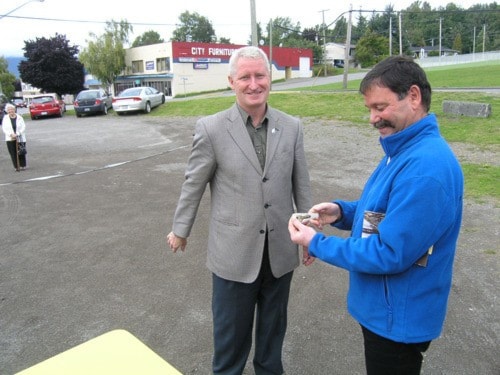MAYORS from three northwest municipalities gathered at the Royal Canadian Legion Branch 13 building Sept. 4 to help re-create the official 1944 opening of the Prince Rupert to Hazelton highway, which is now part of Highway 16.
The ceremony marked 67 years to the day that the 1944 opening took place.
That first opening was marked by the exchange of a ceremonial key between then-Terrace mayor Emil Haugland and HM Daggett, then-mayor of Prince Rupert.
Speakers in 1944 included representatives from the Canadian and American military because the highway was considered a vital part of the military structure during the Second World War in the region.
This time the key exchange was between Terrace mayor Dave Pernarowski and Jack Mussallem, the mayor of Prince Rupert.
Branch 13 past president Les Sinnott, who acted as master of ceremonies, noted that opening of the highway meant “ordinary people could at last travel between communities.”
Pernarowski said the highway now acts as an important conduit for tourism.
“It is truly one of the more beautiful drives in all of British Columbia,” he said, adding that Hwy16 will have an increasingly important role to play as large industrial projects get underway.
Mussallem talked about travelling the highway with his family as a youngster.
“Each mile on that highway was dusty. And you sure knew where the dust was except around Prince Rupert,” said Mussallem in reference to the rainy climate of his hometown.
Kitimat mayor Joanne Monaghan told those at the ceremony that the first vehicle through from Prince Rupert, a car carrying a general, was driven by a woman.
“You see, women do play a role in the world,” she said.
Monaghan also mentioned she was the first woman president of the Yellowhead Highway Association, the collection of local governments and others, which stretches across Western Canada and lobbies for road improvements.
A former Terrace mayor, Dave Maroney, was also on hand in his capacity as a former president (from 1976 to 1981) of the highway association.
He took credit for securing Monaghan’s presidency of the association.
Skeena New Democratic Party MLA Robin Austin, who was part of a tour earlier that day of Second World War buildings and structures, noted the links between the war and the area.
“The reality is that history is us and we’re celebrating history today,” he said.
Maggy Ottenbreit sang the national anthem, piper Murray Hamer played and the Branch 13 colour party was on hand. The ceremony was organized by the Little Townsite/Big Celebration Committee with the assistance of Branch 13 of the Royal Canadian Legion.
Yvonne Moen, who has been organizing events all this year to mark the 100th anniversary of Terrace’s townsite survey, said the recreation ceremony took place on almost the exact spot of the original one in 1944. A tea inside Branch 13 followed.
Dave Maroney told several stories of driving into the area in the early 1950s, recalling that it would often take a whole day to travel between Hazelton and Terrace on what was then a very narrow, windy and rough roadway.
City freeman Bill McRae said the highway has helped make this region one of the best parts of the world in which to live.
“The next thing you know we’ll be talking about too many people and not enough houses,” he said of the list of industrial projects that are about to start.
Jo Sandhals spoke about being at the 1944 highway opening as a 13-year-old school girl and watching the ceremonial ribbon being cut.
